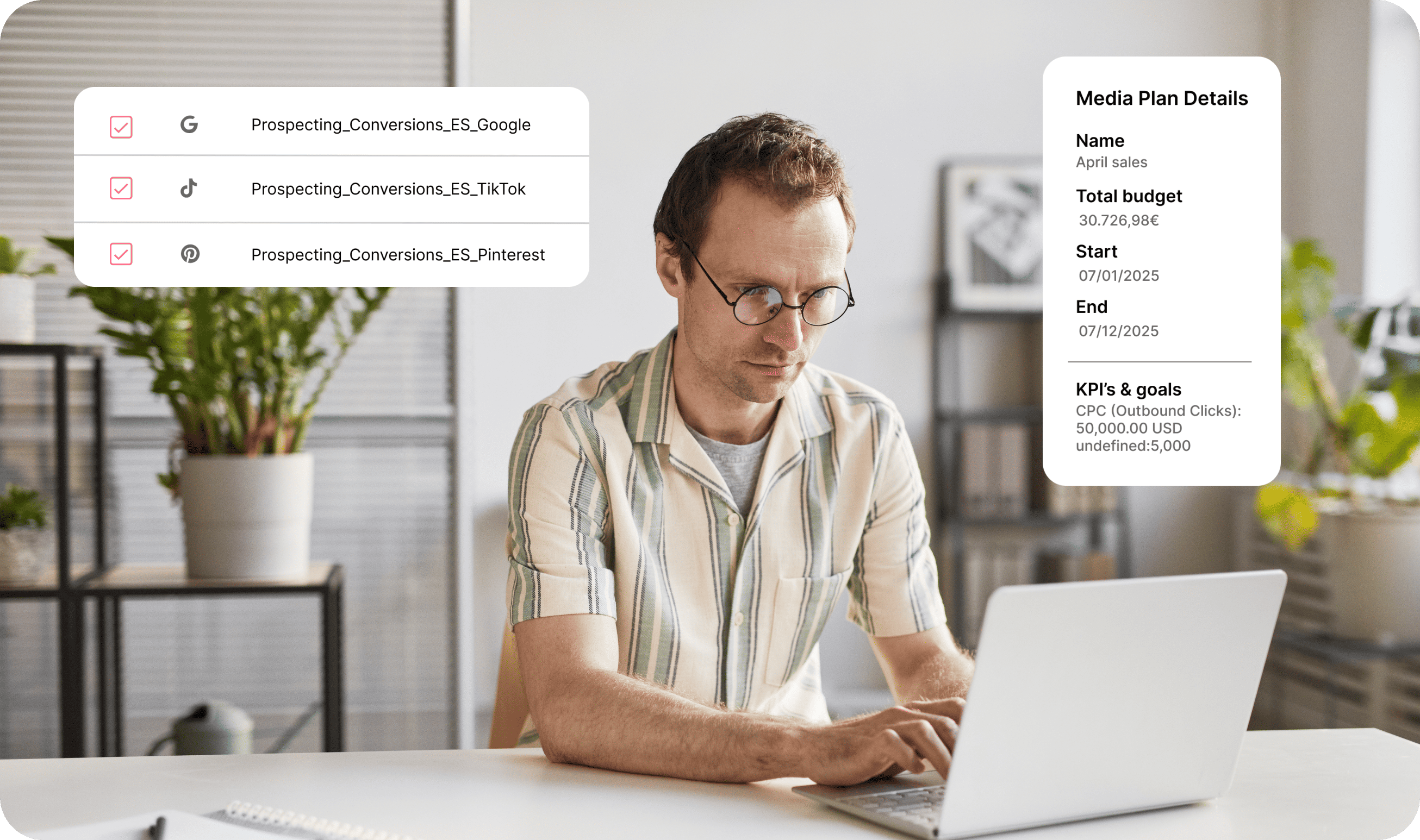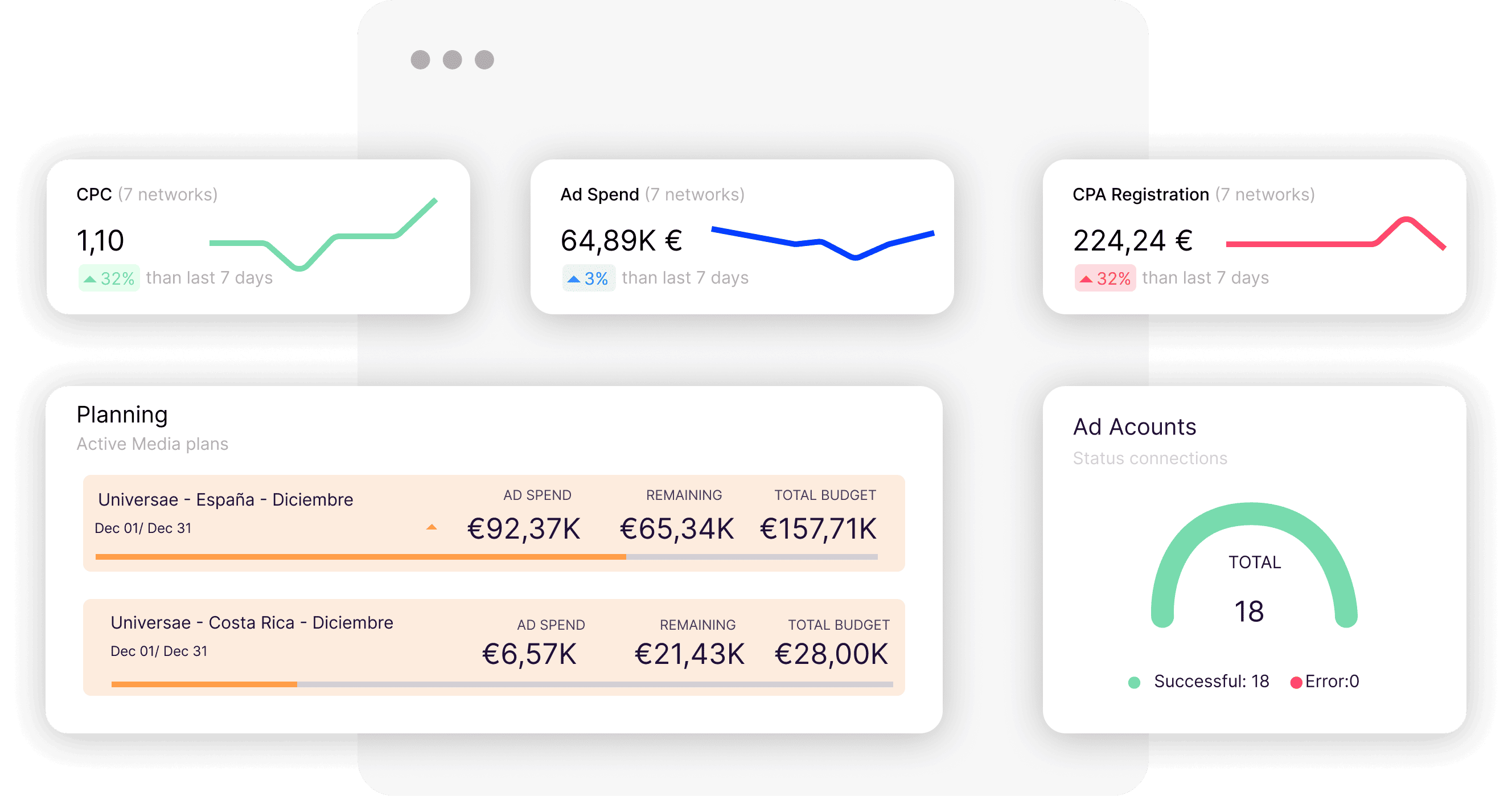Data-Driven Media Planning: How to use real-time data to plan better and make smarter decisions
In a digital environment marked by platform fragmentation, rapid change, and the pressure to maximize results, media planning needs to evolve. It's...
Plan, activate and control media to hit targets with precision.
Turn data into smart decisions with advanced analytics and modeling.
Efficiency, governance and scale for agencies and teams.
![[Ebook] SEO + AI: eBook to Master AI Overviews and GEO](https://www.adsmurai.com/hubfs/MKT%20-%202025/WEB/Resources%20-%20Banners/HeaderEN_Ebook_SEO+AI.png)
[Ebook] SEO + AI: eBook to Master AI Overviews and GEO
Learn how to structure and distribute your content so generative models can understand it, trust it, and reuse it in their answers. A practical guide to compete and appear in AI Overviews and AI-powered assistants.
Discover more
In the dynamic world of marketing and advertising, media planning is the key to ensuring that your campaigns don't get lost in the dust. What a surprise! It turns out that it's important to reach the right audience at the right time and through the right channel. What a surprise!
In this “dynamic” and “ever-evolving” (aka, a little crazy) landscape, it’s vital to get your messaging right. Don’t let your winter clothing campaign end up on the Instagram feed of someone who lives in Hawaii. That would be a little weird!
Furthermore, media planning faces several challenges. Data fragmentation results in scattered reports from multiple platforms, making it difficult to have a unified view of performance. Furthermore, a lack of control and strategic planning prevents efficient management of budgets and resources. This makes decision-making difficult, as the absence of data integration limits real-time analysis and reaction. Finally, operational inefficiency results from manual processes that slow down data consolidation, affecting strategic agility. These obstacles require technological solutions that centralize data, optimize processes and enable agile and efficient campaign management.
How can we overcome these barriers and optimize media planning in an increasingly complex digital landscape? We'll tell you how.
TABLE OF CONTENTS
Media planning is an essential part of the marketing and advertising process that involves the selection and purchase of advertising space in various media to reach a specific audience. This practice seeks to determine when, where and how ads should be displayed to maximise impact and return on advertising investment.
Within media planning, there are various approaches and strategies that suit different marketing objectives and needs. These are the most important types of media planning:

Media planning is a crucial aspect of advertising and marketing strategies and offers several advantages to companies and organisations. Here are some of the main advantages of effective media planning:
Media planning focuses on media strategy and the selection of the most appropriate channels and media to reach the target audience, while media buying deals with the actual execution of the purchase of advertising space in those selected media. Below are the differences:
Media planning: This involves selecting media and channels to promote a product, service or message. The objective is to determine how advertising resources (budget) should be effectively allocated to reach the target audience. It also involves choosing dates, times and frequencies of advertisements in the selected media.
Media Buying: This is the stage where advertising space is negotiated and purchased on the media selected during the media planning phase. Media buying professionals work directly with media representatives to purchase the advertising space. This involves negotiating rates, conditions and contract terms , as well as managing the logistical aspects of campaign implementation, such as ad scheduling and delivery of advertising content . Media buying focuses on getting the best value for the money spent and making sure that the ads are executed as planned.
Both functions are essential to the success of an advertising campaign. Although they are closely related and often work together, they play different roles in the process.
Working effectively on creativity and media selection is crucial in a world where "intoxication" is a palpable reality. We have to be "creative" and "strategic" to stand out. What a challenge!
Just imagine, between 3,000 and 6,000 advertising hits a day! It's like trying to read an entire encyclopedia in one day. But don't worry, because out of all those thousands of messages, we remember about 18! Yes, you read that right, 18! It's almost like finding a needle in a haystack.
Combining highly creative content with a well-thought-out media strategy is the key to standing out. Creativity attracts and retains attention, while good media selection ensures that this creative content effectively reaches those most likely to act on it. This synergy between creativity and media is essential to breaking the cycle of infoxication and ensuring that messages are not only delivered, but also internalized and act as catalysts for purchasing decisions.
Coordination between media planning and creative teams brings a number of tangible benefits that contribute to the success of campaigns:
These are the main recommendations from the Adsmurai team:
Keeping up with the constant changes in digital technologies, social platform algorithms, and consumer trends is essential in the marketing world. With Planning from Adsmurai Marketing Platform you can control the budget of your campaigns, forget about decentralized data, easily optimize the performance of your campaigns, and build media plans from scratch by taking advantage of your campaigns' data analytics. To create a media plan in Planning, there is the Media Plans tool, which defines your strategic planning to distribute your campaign budget and maximize its profit. Choose the business variables that best suit you to determine the investment of your digital channels.
Planning allows you to select key variables such as country, audience and platform, as well as establish KPIs aligned with your business objectives. The platform also facilitates the allocation and distribution of the budget by investment line, with options to link or exclude campaigns according to the defined strategy.

Design multi-platform strategies
In an environment where the speed of change can be overwhelming, Adsmurai Marketing Platform’s Planning allows you to efficiently design cross-platform strategies. You can create customized media plans based on clear objectives, specific audiences, and strategic channels, making it easy to evaluate and justify ROI.
Allocate the budget to get the maximum benefit
Budget constraints are a reality, but with Adsmurai Marketing Platform Planning, you can allocate your campaign budget to achieve maximum benefit.

Track your campaigns across all platforms
Coordinating and communicating effectively across different teams can be tricky, but with Adsmurai, unified ad account management simplifies cross-departmental coordination. Connect your ad accounts and easily view which platforms you’re advertising on and how your campaigns are performing.
Monitor your advertising spend and KPIs in real time
Last-minute changes and tight deadlines are common challenges in digital marketing. With Adsmurai Marketing Platform’s Planning, you can monitor ad spend and key metrics in real-time, allowing you to quickly adjust strategies in the face of sudden changes or tight deadlines.
In short, meet the challenges of media planning with confidence using Adsmurai Marketing Platform's Planning. This tool not only simplifies the complexity of keeping up with a changing environment, but also gives you the tools you need to overcome obstacles such as accurate performance measurement, budget constraints and effective coordination between teams.

In a digital environment marked by platform fragmentation, rapid change, and the pressure to maximize results, media planning needs to evolve. It's...

In an environment where user privacy and the effectiveness of advertising campaigns are increasingly crucial, Google tools such as Customer Match and...

For years, product catalogs have been the silent heart of digital advertising. Thousands of SKUs connected to automated campaigns, dynamic audiences,...